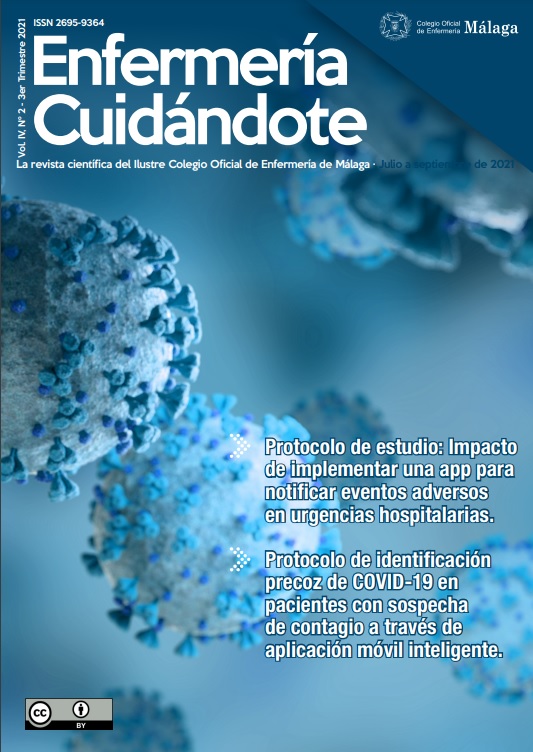Early identification protocol of COVID-19 in patients with suspected contagion through a smart mobile application
DOI:
https://doi.org/10.51326/ec.4.2.9497420Keywords:
Coronavirus, Tos, Herramientas de Salud, e-Salud, e-Health, mSalud, mHealth, plataforma digital, dispositivo móvil., Coronavirus, Cough, Health Tools, e-Health, e-Health, mSalud, mHealth, digital platform, mobile device.Abstract
Background: The COVID pandemic has forced us to explore the opportunities offered by telemedicine for the diagnosis, treatment and management of patients in both specialized and primary care settings. Likewise, APPs for Smartphone have proliferated for the management of COVID_19 cases, but it is necessary to evaluate the performance in clinical practice. Research projects aimed at preventing the spread of the disease and contagion are priority and fundamental for this health and economic problem worldwide.
Justification:Collaborate in the strategic line of Population Health by preventing infection by COVID_19, seeking sustainability of the SAS within the legal ethical margins established by the biomedical research law.
Objectives: General Objectives: To evaluate the performance of the intelligent mobile application for the identification of viral cough by COVID-19 in clinical practice. Specific Objectives: To evaluate the diagnostic capacity of the tool in different subgroups of populations, both in the hospital setting and in primary care, of symptomatic and asymptomatic people, and to evaluate the concordance of results of viral load and lymphocytes in positive patients.
Method: Analytical descriptive cross-sectional study. The study population will be patients with suspected COVID-19 with a positive PCR result and with a negative PCR result, from the Hospital Costa de Sol Healthcare Area and Sanitary District.The inclusion criteria will be patients with suspected Covid-19 infection, who are conscious and oriented, who give their written consent to collaborate in the study. The exclusion criteria will be unconscious patients or patients who do not understand the study due to their language difficulties and / or do not want to participate. Study period 1 year; that from January 15, 2021 to January 15, 2022. Sample: For an expected sensitivity of 95%, Specify 90%, and a 2: 1 ratio in non-COVID patients among those who manifest symptoms, for a precision of 4 %, and a confidence level of 95%, a total of 345 patients will need to be assessed (115 sick and 230 healthy, at least). An attempt will be made to follow a sampling segmentation similar to that provided by the WHO and the National Epidemiological Surveillance Network (Informes COVID-19, s. F.), Depending on the demographic distribution of COVID-19 patients represented in the hospital. Priority groups to include in the sample are 65+ (men and women) 40%, 45-64 (men and women) 34%, 15-44 (men and women) 26%.
Statistical plan: Descriptive analysis will be carried out using measures of central tendency, dispersion and position for quantitative variables, and frequency distribution, both for the complete study sample, as well as different segmentations that are determined. The main results of the study will be the diagnostic performance using classic tests (sensitivity, specificity, positive and negative predictive values) with the corresponding 95% confidence intervals. This project is relevant in that the world health organization (WHO) and the scientific community have asked governments to make efforts to detect asymptomatic cases in people and prevent the spread of the disease.
Downloads
References
Anderson, R.M., Heesterbeek, H., Klinkenberg, D. y Hollingsworth, T.D. (2020) "How will country-based mitigation measures influence the course of the COVID-19 epidemic?", The Lancet, 395(10228), pp. 931-934. https://doi.org/10.1016/S0140-6736(20)30567-5
Bedford, J., Enria, D., Giesecke, J., Heymann, D.L., Ihekweazu, C., Kobinger, G., Lane, H.C., Memish, Z., Oh, M., Sall, A.A., Schuchat, A., Ungchusak, K. y Wieler, L.H. (2020) "COVID-19: Towards controlling of a pandemic", The Lancet, 395(10229), pp. 1015-1018. https://doi.org/10.1016/S0140-6736(20)30673-5
Cohen, J. y Kupferschmidt, K. (2020) "Countries test tactics in ‘war’ against COVID-19", Science, 367(6484), pp. 1287-1288. https://doi.org/10.1126/science.367.6484.1287
Cooper, H., Reif, S., Shilling, S. y Wilson, E. (2020) "Social media support group: Implementation and evaluation" AIDS Care, pp. 502-506. https://doi.org/10.1080/09540121.2020.1748171
Eliezer, M., Hautefort, C., Hamel, A.L., Verillaud, B., Herman, P., Houdart, E. y Eloit, C. (2020) "Sudden and Complete Olfactory Loss of Function as a Possible Symptom of COVID-19", JAMA Otolaryngology–Head & Neck Surgery, 146(7), p. 674-675. https://doi.org/10.1001/jamaoto.2020.0832
Fitch, K., Pelizzari, P. M., y Pyenson, B. (2016) "Inpatient Utilization and Costs for Medicare Fee-for-Service Beneficiaries with Heart Failure", American Health & Drug Benefits, 9(2), pp. 96-104.
Guha, K. y McDonagh, T. (2013) "Heart failure epidemiology: European perspective", Current Cardiology Reviews, 9(2), pp. 123-127. https://dx.doi.org/10.2174/1573403X11309020005
Heckman, G.A., McKelvie, R.S. y Rockwood, K. (2018) "Individualizing the care of older heart failure patients", Current Opinion in Cardiology, 33(2), pp. 208-216. https://doi.org/10.1097/HCO.0000000000000489
Infante, C., Chamberlain, D.B., Kodgule, R. y Fletcher, R.R. (2017) "Classification of voluntary coughs applied to the screening of respiratory disease", 2017 39th Annual International Conference of the IEEE Engineering in Medicine and Biology Society (EMBC), pp. 1413-1416. https://doi.org/10.1109/EMBC.2017.8037098
Jowsey, T., McRae, I., Gillespie, J., Banfield, M. y Yen, L. (2013) "Time to care? Health of informal older carers and time spent on health related activities: an Australian survey", BMC Public Health, 13, 374. https://doi.org/10.1186/1471-2458-13-374
Keshvardoost, S., Bahaadinbeigy, K., & Fatehi, F. (2020) "Role of Telehealth in the Management of COVID-19: Lessons Learned from Previous SARS, MERS, and Ebola Outbreaks", Telemedicine and E-Health, 26(7), pp. 850-852. https://doi.org/10.1089/tmj.2020.0105
Lai, C.-C., Shih, T.-P., Ko, W.-C., Tang, H.-J. y Hsueh, P.-R. (2020) "Severe acute respiratory syndrome coronavirus 2 (SARS-CoV-2) and coronavirus disease-2019 (COVID-19): The epidemic and the challenges", International Journal of Antimicrobial Agents, 55(3), 105924. https://doi.org/10.1016/j.ijantimicag.2020.105924
Lazarus, J.V., Baker, L., Cascio, M., Onyango, D., Schatz, E., Smith, A.C. y Spinnewijn, F. (2020) "Novel health systems service design checklist to improve healthcare access for marginalised, underserved communities in Europe", BMJ Open, 10(4), e035621. https://doi.org/10.1136/bmjopen-2019-035621
Li, L., Huang, T., Wang, Y., Wang, Z., Liang, Y., Huang, T., Zhang, H., Sun, W. y Wang, Y. (2020) "COVID‐19 patients’ clinical characteristics, discharge rate, and fatality rate of meta-analysis", Journal of Medical Virology, 92(6), pp. 577-583. https://doi.org/10.1002/jmv.25757
Llorens, P., Martín-Sánchez, F.J., Jacob, J., Herrero-Puente, P., Gil, V., Garrido, J.M., Salvo, E., Fuentes, M., Alonso, H., Richard, F., Lucas, F.J., Bueno, H., Parissis, J., Müller, C.E. y Miró, Ò. (2018) "Time trends in characteristics, clinical course, and outcomes of 13,791 patients with acute heart failure", Clinical Research in Cardiology, 107(10), pp. 897-913. https://doi.org/10.1007/s00392-018-1261-z
Nazari, S., Farokhnezhad Afshar, P., Sadeghmoghadam, L., Namazi Shabestari, A., Farhadi, A. (2020) "Developing the perceived social support scale for older adults: A mixed-method study", AIMS Public Health, 7(1), pp. 66-80. https://doi.org/10.3934/publichealth.2020007
Northwood, M., Ploeg, J., Markle-Reid, M., y Sherifali, D. (2018) "Integrative review of the social determinants of health in older adults with multimorbidity", Journal of Advanced Nursing, 74(1), pp. 45-60. https://doi.org/10.1111/jan.13408
Organización Mundial de la Salud (2020) WHO Coronavirus (COVID-19) Dashboard. Disponible en: https://covid19.who.int/ [Consultado 18-08-2020]
Polikandrioti, M., Vasilopoulos, G., Koutelekos, I., Panoutsopoulos, G., Gerogianni, G., Alikari, V., Dousis, E. y Zartaloudi, A. (2020) "Depression in diabetic foot ulcer: Associated factors and the impact of perceived social support and anxiety on depression", International Wound Journal, 17(4), pp. 900-909. https://doi.org/10.1111/iwj.13348
Qiu, J. (2020) "Covert coronavirus infections could be seeding new outbreaks", Nature. https://doi.org/10.1038/d41586-020-00822-x
Ren, X., Zhai, Y., Song, X., Wang, Z., Dou, D., y Li, Y. (2020) "The Application of Mobile Telehealth System to Facilitate Patient Information Presentation and Case Discussion", Telemedicine and E-Health, 26(6), pp. 725-733. https://doi.org/10.1089/tmj.2020.0084
Robinson, B.C. (1983) "Validation of a Caregiver Strain Index", Journal of Gerontology, 38(3), pp. 344-348.
Rutter, E.C., Tyas, S.L., Maxwell, C.J., Law, J., O’Connell, M.E., Konnert, C.A. y Oremus, M. (2020) "Association between functional social support and cognitive function in middle-aged and older adults: A protocol for a systematic review", BMJ Open, 10(4), p. e037301. https://doi.org/10.1136/bmjopen-2020-037301
Salvador-Piedrafita, M., Malmusi, D., Mehdipanah, R., Rodríguez-Sanz, M., Espelt, A., Pérez, C., Solf, E., Abajo Del Rincón, M., y Borrell, C. (2017) "Views on the Effects of the Spanish Dependency Law on Caregivers’ Quality of Life Using Concept Mapping", International Journal of Health Services, 47(2), pp. 233-257. https://doi.org/10.1177/0020731416685494
Sossai, P., Uguccioni, S. y Casagrande, S. (2020) "Telemedicine and the 2019 coronavirus (SARS-CoV-2)", International Journal of Clinical Practice, 74(10), e13592. https://doi.org/10.1111/ijcp.13592
Swarnkar, V., Abeyratne, U.R., Amrulloh, Y.A. y Chang, A. (2012) "Automated algorithm for Wet/Dry cough sounds classification", 2012 Annual International Conference of the IEEE Engineering in Medicine and Biology Society, pp. 3147-3150. https://doi.org/10.1109/EMBC.2012.6346632
Wu, H.-Y. y Chiou, A.-F. (2020) "Social media usage, social support, intergenerational relationships, and depressive symptoms among older adults", Geriatric Nursing, 41(5), pp. 615-621. https://doi.org/10.1016/j.gerinurse.2020.03.016




















